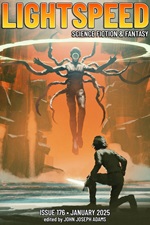“Tell Them a Story to Teach Them Kindness” by B. Pladek
“A Heap of Petrified Gods” by Adelehin Ijasan
“The Exquisite Pull of Relentless Desire” by Will McMahon
“Bone and Marrow, Woven into Song” by Neon Yang
“Dyson Spheres of the Vaba Cluster” by Filip Hajdar Drnovšek Zorko
“I Eat the Sky for Us” by Vijayalaxmi Samal
“After the God Has Moved On” by Kate Elliott
“Chickenfoot Soup” by Marika Bailey
Reviewed by Victoria Silverwolf
“Tell Them a Story to Teach Them Kindness” by B. Pladek takes place in a future United States divided into separate nations after a civil war. The protagonist works with a non-sentient artificial intelligence, much like today’s AI’s, that comes up with stories to teach moral lessons to schoolchildren. Secretly, he uses classic works of literature instead of these artificially generated works.
This epistolary story, made up of letters, memos, and online conversations, deals with more themes than I have indicated. These are handled in a mature, thoughtful way. The protagonist is a flawed but sympathetic character. The situation ends in a way that is both downbeat and hopeful, reflecting the complexities of the real world.
(It should be noted here that the early part of the text suggests yet another response to Ursula K. LeGuin’s classic story “The Ones Who Walk Away from Omelas,” many examples of which exist. However, the present work goes beyond this, mentioning other stories and delving into multiple issues rather than simply answering LeGuin.)
In “A Heap of Petrified Gods” by Adelehin Ijasan, the narrator carries a small ancestral god when moving to a new nation. To remain a resident, the narrator must give up things like childhood memories and a sense of humor, finally paying the ultimate price.
The story serves as a clear metaphor for immigrants losing parts of their culture. Although the premise is clearly fantasy, some aspects of the plot are treated as if they were science fiction. The blending of the two genres is not always graceful.
In “The Exquisite Pull of Relentless Desire” by Will McMahon, a dancer in a spacecraft entering a black hole performs for viewers who become sexually excited. This brief work is more of a prose poem than a fully developed story. Although vividly described, the notion that impending doom within a black hole could lead to erotic ecstasy is likely to strike readers as unlikely.
“Bone and Marrow, Woven into Song” by Neon Yang features an alien fungus that grows into huge structures on Earth. These are used as places of worship by a sect devoted to the fungus. The plot deals with a member of the sect planting a sample of fungus that will grow into a new church, and the effect this has on a local inhabitant.
One peculiar aspect of the premise is that the fungus allows communities to have advanced technology, such as limitless energy and hover cars, while those without it are limited to electricity and surface vehicles. I never understood how this happens, and it can be seen as an overly convenient plot device. (The access to technology encourages communities to accept the fungus, even though some people strongly oppose it.) Aside from this quibble, the story can be appreciated as a study in the power of religion in both positive and negative ways.
“Dyson Spheres of the Vaba Cluster” by Filip Hajdar Drnovšek Zorko describes a variety of the immense structures mentioned in the title, as space travelers voyage from one to another. Although the text contains characters who react in different ways and make important decisions, it is mostly a travelogue. The Dyson spheres are interesting, particularly the one that has no purpose other than as a work of art, but readers may wish for more of a plot.
In “I Eat the Sky for Us” by Vijayalaxmi Samal, the narrator’s father transforms into a giant winged being in order to protect his family from pieces of the sky falling on them. There is not much more to this fairly short work other than its surreal premise, although it may be possible to read it as an account of the complex relationship between parent and child.
“After the God Has Moved On” by Kate Elliott features an inhabitant of a space station who has been possessed by a deity for quite some time, and what happens when she recovers her own identity. At well under eight hundred words, this tiny work lacks room to develop its premise, despite an interesting background and a provocative combination of space opera and mythology.
“Chickenfoot Soup” by Marika Bailey is the issue’s longest story, just barely reaching novelette length. Set on a Caribbean island, it features a woman whose young daughter is the result of her seduction by an authority figure when she was in her early teens. Adding to her difficulties is her unhappy relationship with her mother. An encounter with Baba Yaga, a supernatural being from Slavic folklore, gives her the opportunity to prevent her daughter from suffering the same fate.
Introducing a figure from Eastern European legends into a Caribbean setting is intriguing, as is the frequent use of blood as a symbol throughout the story. Although the woman’s desire to protect her daughter is certainly understandable, some readers may find that the way she does it is too extreme.
Victoria Silverwolf has read “The Ones Who Walk Away from Omelas” multiple times, as well as several responses to it.
 Lightspeed
Lightspeed